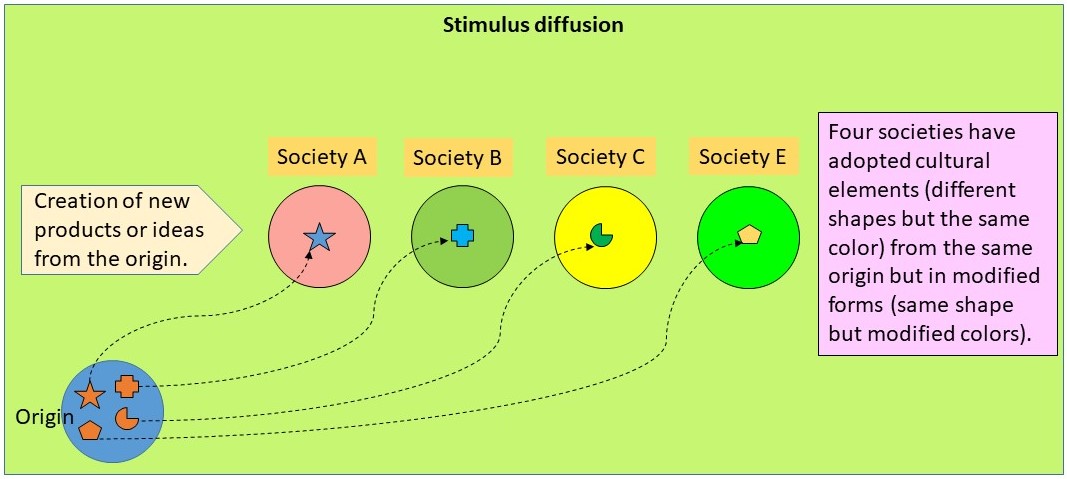Stimulus diffusion is a cultural diffusion in which people receive a cultural element from another but in a new and unique form. The further a cultural element spreads, the more it changes. As stimulus diffusion catches a trend, it changes as adopted by different groups—for example, the change in Pizza after it spread to the United States from Italy, the evolution of Hinduism practices through South Asia, differences in musical taste, and the development of different football codes worldwide.
An American anthropologist, Alfred Louis Kroeber (1940), describes stimulus diffusion as saying that as culture spreads to new areas, it changes. He further explains that diffused cultural aspects, often include concrete and specific elements, by which the reality of diffusion can be subsequently recognized even without a record of the event.
Stimulus diffusion accepts the underlying idea of other cultures but not only the specific part of the culture. The Siberian people learned to domesticate reindeer after observing domesticated cattle in other cultural societies. Cattle were useless for the Siberian people, but they took the idea of domestic herds of animals. Then, they started domesticating reindeer, an animal they had long hunted (Domos et al., 2011).
In the figure below, the diffusion of culture to other different societies from its origin. Another society adopted the essence idea or product from its origin in somehow modified and changed form, which is suitable for their locality.

Some Examples of Stimulus Diffusion
Here are some examples of stimulus diffusion:
1. Globalization
Globalization is the spread of culture around the globe, but culture doesn’t spread the whole part of it. Local cultures in different parts of the world take what they like and reject what they do not want from other cultures.
2. Football game
Among the upper classes in England, soccer gave rise to rugby, which later evolved into American football, Australian football, and Australian rugby league, all with their regulations.
3. Spread of rock music
Various forms of rock music originated globally and developed from earlier versions. For instance, punk and rock from England, New York, and Los Angeles influenced the grunge movement in Seattle.
3. Pizza dish
Different, distinct types of pizza developed after spreading from Italy to New York and the United States as people adapted to their dishes.
4. Hip-Pop Rap
Rap and hip-hop originated in New York and moved west, giving rise to two distinct types of rap such as East Coast and West Coast rap.
5. Porcelain in Europe from China
China first brought porcelain to Europe. Then, in the eighteenth century, Europeans developed technology to produce it locally.
6. Cherokee syllabary
Sequoya, a Cherokee Nation polymath and Native American, created the Cherokee syllabary in 2021. Some symbols have letters similar to Latin, Greek, Cyrillic, and Glagolitic. Some are developed, others are modified.
7. Writing systems of Egyptians and Mesopotamians
Egyptian and Mesopotamian writing systems influenced and changed each other (Kroeber, 1940).
8. Algebra
In the thirteenth and fourteenth centuries, China developed algebra, largely by Zhu Shijie (1249–1314). Chinese algebra was different than its predecessors but influenced by its origin.
9. Domestication of animals
Domestication of livestock in different societies learned the idea from the domestication of raindeers by the Siberian Society.
10. Daoism in Japan
At first, Daoism originated in China and spread in Japan in a modified form because Japanese people modified it to suit their locality (Sekimori, 2018).
11. Chinese and Japanese writing
The Chinese Writing System’s Impact The advent of Kanji marked the most important shift in the development of Japanese characters. Kanji are logographic symbols that stand in for entire words or ideas. The writing system advanced to a new degree of complexity.
12. French influence on the English language
The influences of French vocabulary, grammar, orthography, and pronunciation on the English language are an example of stimulus diffusion.
13. Monasticism
Living a peaceful, separated, and religious life through self-imposed segregation is known as monasticism, and spreads from Buddhism to other religions, changing each one’s taste.
14. Hinduism in Indonesia
The Hindu religion originated in India, but the practice of the Hindu religion is different in different countries. There are unique practices of special daily blessings in Bali, Indonesia, that does not exist in other parts of the world.
